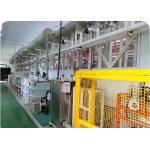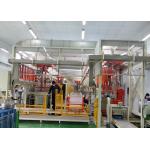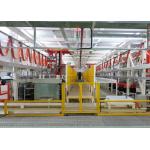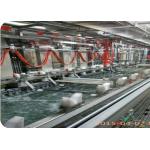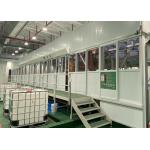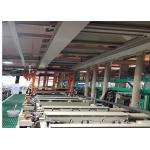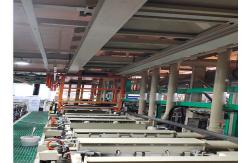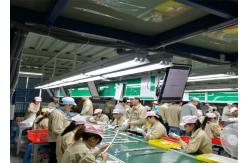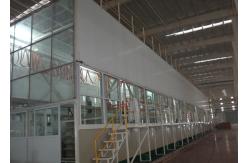In the manufacturing industry, electroplating is a crucial process
for enhancing the properties of metal objects. It not only improves
the aesthetic appeal but also provides protection against
corrosion, wear, and other environmental factors. The
electroplating setup, consisting of a copper plating PP tank,
electroplating line, anodizing components, and electroplated
barrels for nickel, zinc, and chrome plating, offers a
comprehensive solution for a wide range of applications. This
system is designed to meet the diverse needs of industries such as
automotive, electronics, and jewelry.
The copper plating PP (polypropylene) tank is the heart of the
copper - plating process. PP is chosen for its excellent chemical
resistance, which is essential as the tank holds the copper -
plating solution. This solution contains chemicals that can be
corrosive to many materials, but PP can withstand these harsh
conditions over an extended period. The tank is carefully
constructed to ensure a leak - proof and durable structure. It has
a smooth interior finish to prevent any accumulation of plating
residues, which could affect the quality of the plating process.
The copper - plating PP tank serves as the container where the
actual copper - plating reaction takes place. Metal objects are
immersed in the copper - plating solution, and an electric current
is passed through the system. The positive ions in the solution are
attracted to the negatively charged metal objects, causing a layer
of copper to deposit on their surfaces. The tank's design allows
for proper circulation of the plating solution, ensuring an even
distribution of copper ions. This results in a uniform copper
coating on the objects, which is crucial for maintaining consistent
quality in the final product.
The electroplating line is a series of interconnected stations that
streamline the electroplating process. It typically includes pre -
treatment stations for cleaning and preparing the metal surfaces,
the actual plating stations, and post - treatment stations for
rinsing and drying the plated objects. The line can be automated to
a high degree, with programmable logic controllers (PLCs)
regulating the movement of objects between stations, the duration
of each process, and the application of electrical currents. This
automation not only increases the efficiency of the plating process
but also reduces human error, leading to more consistent and high -
quality results.
Throughout the electroplating line, there are multiple quality
control points. Sensors are installed at various stations to
monitor parameters such as temperature, pH levels, and chemical
concentrations in the plating solutions. This real - time
monitoring ensures that the plating process is carried out under
optimal conditions. If any parameter deviates from the set values,
the system can automatically adjust or alert the operator,
preventing the production of defective plated parts.
Anodizing is a specialized form of electroplating, particularly for
metals like aluminum. In this process, the metal object is made the
anode in an electrolytic cell. When an electric current is applied,
oxygen is generated at the anode, which reacts with the metal
surface to form a protective oxide layer. This oxide layer can be
further enhanced with coloring agents to achieve different
aesthetic effects. Anodizing not only improves the corrosion
resistance of the metal but also increases its hardness, making it
suitable for applications where durability is crucial.
Anodized products find extensive use in various industries. In the
automotive industry, anodized aluminum parts are used for their
lightweight yet durable properties. For example, anodized aluminum
wheels are not only corrosion - resistant but also add an aesthetic
touch to the vehicle. In the electronics industry, anodized
aluminum enclosures provide protection for sensitive components
while also offering a sleek appearance.
Nickel - plating barrels are designed to hold small - to - medium -
sized metal parts during the nickel - plating process. The barrels
are made of materials that are resistant to the nickel - plating
solution and can rotate, ensuring that all parts are evenly exposed
to the solution. Nickel plating provides excellent corrosion
resistance and a smooth, shiny finish. It is commonly used in the
manufacturing of hardware, such as nuts, bolts, and hinges, as well
as in the electronics industry for components that require good
electrical conductivity and corrosion protection.
Zinc - plating barrels are specifically designed for the zinc -
plating process. Zinc plating is widely used for its sacrificial
protection properties. When a zinc - plated metal is exposed to a
corrosive environment, the zinc corrodes first, protecting the
underlying metal. The barrels ensure that the zinc - plating
solution reaches all parts of the objects inside, providing a
uniform zinc coating. Zinc - plated parts are commonly used in the
construction and automotive industries, where protection against
rust is essential.
Chrome - plating barrels are engineered to handle the unique
requirements of chrome plating. Chrome plating is known for its
bright, reflective finish and high hardness. The barrels are
designed to rotate the parts in the chrome - plating solution,
ensuring an even and smooth chrome layer deposition. Chrome -
plated parts are popular in the automotive, jewelry, and decorative
industries, where their aesthetic appeal and durability are highly
valued.
| Machine type | Electroplating machine |
| Warranty | 1 Year |
| Weight(kg) | 19500 |
| Test Report | Provided |
| Core components | PLC, Engine, Bearing, Gearbox, motor, Pressure vessel, Gear, Pump |
| dimension(l*w*h) | Customized |
| key selling points | Easy to Operate |
| Electroplating machine application< |
